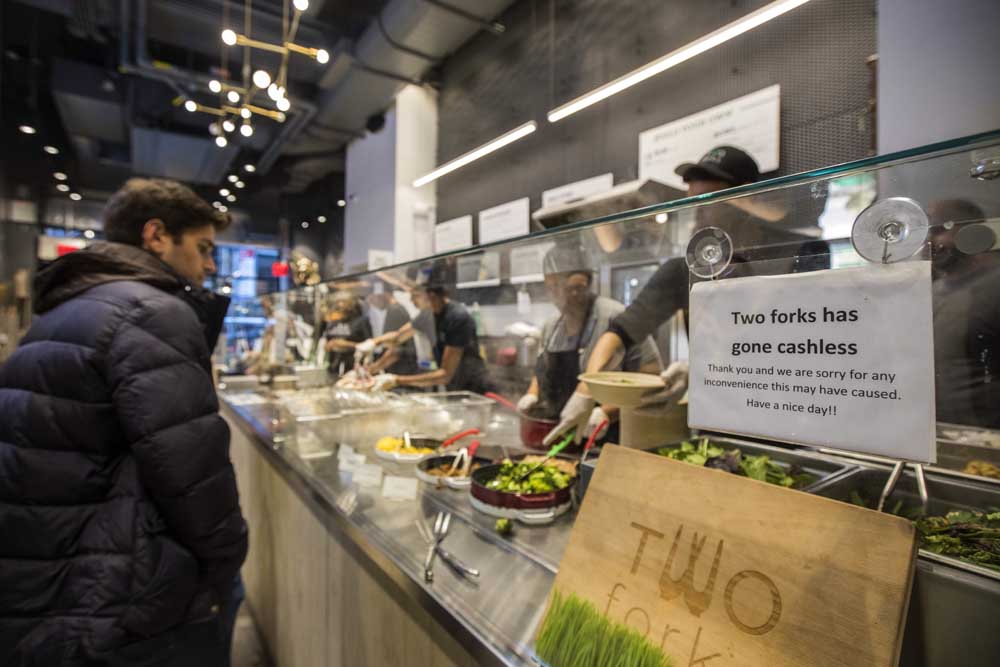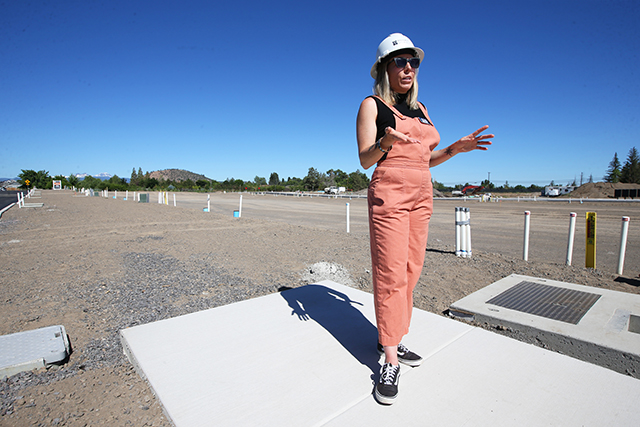Cash may be king, but some don’t want it
Published 8:18 am Tuesday, December 26, 2017

- A sign announcing that Two Forks restaurant does not accept cash, only credit or debit cards, in New York, Dec. 20, 2017. A growing number of New York businesses do not accept U.S. currency, to the consternation of some and the indifference of others. (Hiroko Masuike/The New York Times)
NEW YORK — The other day at Dig Inn, a just-opened lunch spot on Broadway and 38th Street in Midtown Manhattan, Shania Bryant committed a consumer faux pas. She placed her order for chicken and brown rice and yams, and when she got to the register, she held out a $50 bill.
“Sorry,” the cashier told her. “We don’t take cash.” Not, “We don’t take 50s.” No cash. Period.
Trending
“What?” Bryant asked.
The cashier patiently explained. Credit and debit cards were fine, as was the easy-to-download Dig Inn phone app. But the almighty dollar was powerless.
“I’ve never experienced that before,” said Bryant, 20, an assistant to a designer. “I guess we’re in new times.”
Indeed. Cashless businesses were once an isolated phenomenon, but now, similarly jarring experiences can be had across the street at Sweetgreen, or two blocks up at Two Forks, or next door to Two Forks at Dos Toros, or over on 41st Street at Bluestone Lane coffee. In Midtown and some other neighborhoods around the city, cashless is fast on its way to becoming normal.
But it is not quite normal yet. So the cashier at Dig Inn cut Bryant a break.
“Just this one time, we’ll give it to you on the house,” she said, handing over the bag. “But just so you know, in the future.”
Trending
Ah, the future. In the future, when dollar bills are found only in museum display cases, we will look back on this moment of transition and confusion with the same head-shaking smile with which we regard customs on the Isle of Yap in Micronesia, where giant stone discs are still accepted as payment for particularly big-ticket items.
Some people already live in this cashless future. They find nothing strange about paying for a pack of gum with a swipe of a card. If you are one of these people and you are still somehow reading this article, you may be thinking, “What on earth is the big deal?”
At Two Forks on 40th Street, where the lunch offerings have cheery names like Squash Goals, Kristin Junco, a 34-year-old auditor for the state Education Department, said she had not used cash for about a week and much prefers a cashless establishment to its opposite. “We travel a lot for work,” she said, gesturing to a colleague, “and if they don’t take credit cards that makes things difficult.”
On the other side are those who were raised to equate credit-card spending with taking on debt — something to be avoided whenever possible, and reserved in any case for major expenditures. Those people do things like grab a $5 bill from their purse and run down from their office to the place on the corner thinking that they can buy a snack with it. They will catch on eventually.
“I was shocked,” said David, a 66-year-old accountant who popped into Dig Inn for lunch a few hours before Bryant. (He declined to give his last name because “I’m a private person.”) “This is very unusual to me.”
Not surprisingly, the credit card companies, who make a commission on every credit card purchase, applaud the trend. Visa recently offered select merchants a $10,000 reward for depriving customers of their right to pay by the method of their choice. A Visa executive described this practice to CNN as offering shoppers “freedom from carrying cash.”
But wait, how is this even allowed? Doesn’t the dollar bill say it’s “legal tender for all debts, public and private.” The Federal Reserve’s website says that notwithstanding that language, there is no federal law compelling a business “to accept currency or coins as payment for goods or services.”
Asked why the $8.71 a customer owes for that Turmeric Sweet Potato Hummus Toast she just ordered is not considered a debt, the Federal Reserve offered a partial explanation, but it begins with the words “for purposes of illustration, and not for attribution to the Fed,” so we can’t share the rest. But a professor at NYU Law School who teaches contract and commercial law, Clayton Gillette, laid it out.
First of all, he said, you don’t have a debt until after you receive a good or a service. What about at a sit-down restaurant, where you pay after you eat? “Assuming the restaurant lets you know up front that they don’t take cash, they’re offering to serve you a meal, but they are offering it on their terms,” Gillette said. “If you consume the meal, you’ve accepted the terms of the contract.”
Still, occasionally, the Luddites win. A couple of weeks ago, Lisa Gaytan, 60, and a friend walked into a Van Leeuwen Artisan Ice Cream store in Boerum Hill, Brooklyn. Her friend ordered a vegan chocolate cone. He was told he could not pay with cash. He handed over his credit card. There was a problem with the card reader, or maybe the Wi-Fi. In any case, the machine was down. The cashier apologized and said the ice cream was on the house.
“My thought was, sometimes the analog world works better that the digital,” Gaytan said. “We both walked out of there saying ‘That was crazy.’”








